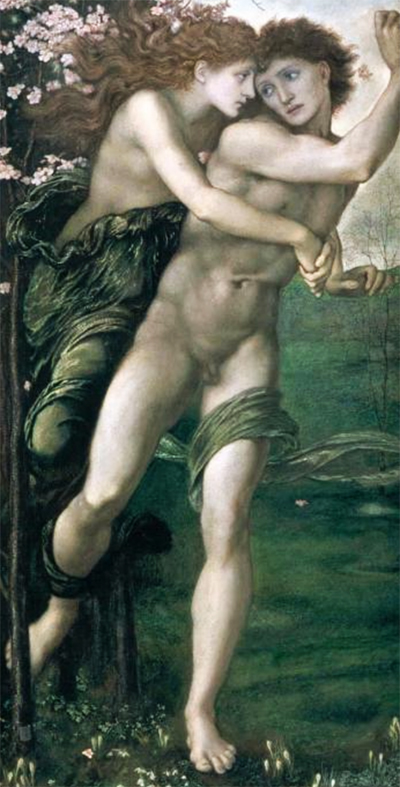The Phyllis & Demophoon painting by Sir Edward Burne-Jones is based on the Greek myth of Phyllis and Demophoon. In the story, Demophoon and Phyllis fell in love after the conquest of Troy. Demophoon stayed with Phyllis the king's daughter at Thracian court where they agreed to marry but he had to go for six months to Attica where his father Theseus was.
Demophoon is said to have stayed too long in Attica that Phyllis was so heartbroken to the point of hanging herself. She was turned into an almond tree which Demophoon embraces in the image and the tree suddenly blossoms and Phyllis reappears and forgives him. The painting is a visual description of this story of love, betrayal, remorse and forgiveness. Phyllis and Demophoon is a body colour and water colour painting with an addition of gold medium and gum Arabic painted on canvas. The material used is paper and it has a dimension of 938mm height and 475mm width. The painting was presented to the Birmingham Museum and Art Gallery by John Feeny Charitable Trust in 1916.
The painter, Burne Jones first specialized in watercolours but he later changed his works into large-scale colourful oil paintings and glass window designs. Burne-Jones artistic life started in oxford when painting the walls of the oxford union with Morrison. Morrison would later become his friend as both shared the same liking for poetry. The two artists were greatly influenced by Dante Gabriel Rossetti even before they met him. They would finally meet him and recruit him as a contributor to their Magazine. Rossetti influenced Burne-Jones to drop his interests in becoming a church minister and become an artist instead. Rossetti’s influence made Burne-Jones Leave College and enrol into a degree to pursue a career in art.
Sir Edward Coley Burne-Jones is considered as one of the best English painter in the nineteenth –century. His art relates to the latter phase of the Pre-Raphaelite art movement. These artists believed that art should be highly valued as a beauty but not as a subject to society morals. They also emphasized the aesthetic values of art more than its social and political themes. Most of the arts from these group of artists focused on the beauty part of art with little or no focus in its deeper meaning. Their argument was that art should be used for sensuous pleasure and not to convey moral messages to the society.




